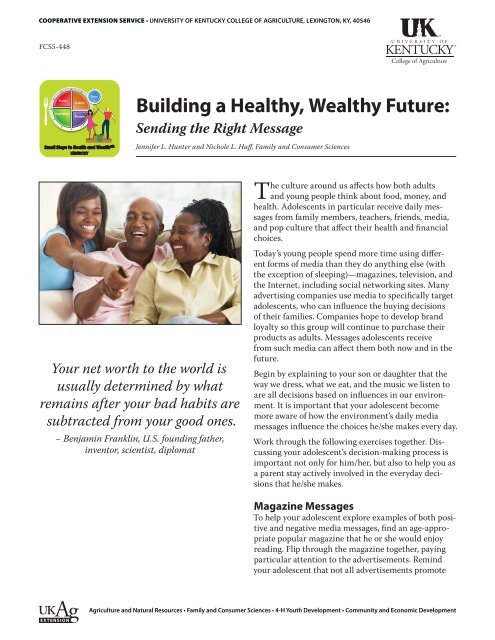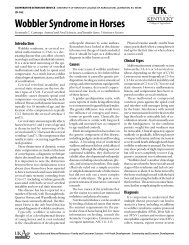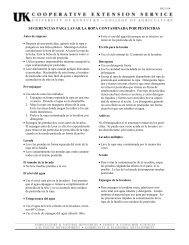FCS5-448: Building a Healthy, Wealthy Future: Sending the Right ...
FCS5-448: Building a Healthy, Wealthy Future: Sending the Right ...
FCS5-448: Building a Healthy, Wealthy Future: Sending the Right ...
You also want an ePaper? Increase the reach of your titles
YUMPU automatically turns print PDFs into web optimized ePapers that Google loves.
COOPERATIVE EXTENSION SERVICE • UNIVERSITY OF KENTUCKY COLLEGE OF AGRICULTURE, LEXINGTON, KY, 40546<br />
<strong>FCS5</strong>-<strong>448</strong><br />
Small Steps to Health and Wealth<br />
EXTENSION<br />
$<br />
$<br />
KENTUCKY<br />
$<br />
$<br />
$<br />
$<br />
$<br />
$<br />
$<br />
$<br />
$<br />
$<br />
<strong>Building</strong> a <strong>Healthy</strong>, <strong>Wealthy</strong> <strong>Future</strong>:<br />
<strong>Sending</strong> <strong>the</strong> <strong>Right</strong> Message<br />
Jennifer L. Hunter and Nichole L. Huff, Family and Consumer Sciences<br />
Your net worth to <strong>the</strong> world is<br />
usually determined by what<br />
remains after your bad habits are<br />
subtracted from your good ones.<br />
− Benjamin Franklin, U.S. founding fa<strong>the</strong>r,<br />
inventor, scientist, diplomat<br />
The culture around us affects how both adults<br />
and young people think about food, money, and<br />
health. Adolescents in particular receive daily messages<br />
from family members, teachers, friends, media,<br />
and pop culture that affect <strong>the</strong>ir health and financial<br />
choices.<br />
Today’s young people spend more time using different<br />
forms of media than <strong>the</strong>y do anything else (with<br />
<strong>the</strong> exception of sleeping)—magazines, television, and<br />
<strong>the</strong> Internet, including social networking sites. Many<br />
advertising companies use media to specifically target<br />
adolescents, who can influence <strong>the</strong> buying decisions<br />
of <strong>the</strong>ir families. Companies hope to develop brand<br />
loyalty so this group will continue to purchase <strong>the</strong>ir<br />
products as adults. Messages adolescents receive<br />
from such media can affect <strong>the</strong>m both now and in <strong>the</strong><br />
future.<br />
Begin by explaining to your son or daughter that <strong>the</strong><br />
way we dress, what we eat, and <strong>the</strong> music we listen to<br />
are all decisions based on influences in our environment.<br />
It is important that your adolescent become<br />
more aware of how <strong>the</strong> environment’s daily media<br />
messages influence <strong>the</strong> choices he/she makes every day.<br />
Work through <strong>the</strong> following exercises toge<strong>the</strong>r. Discussing<br />
your adolescent’s decision-making process is<br />
important not only for him/her, but also to help you as<br />
a parent stay actively involved in <strong>the</strong> everyday decisions<br />
that he/she makes.<br />
Magazine Messages<br />
To help your adolescent explore examples of both positive<br />
and negative media messages, find an age-appropriate<br />
popular magazine that he or she would enjoy<br />
reading. Flip through <strong>the</strong> magazine toge<strong>the</strong>r, paying<br />
particular attention to <strong>the</strong> advertisements. Remind<br />
your adolescent that not all advertisements promote<br />
Agriculture and Natural Resources • Family and Consumer Sciences • 4-H Youth Development • Community and Economic Development
negative messages. For example, an advertisement for<br />
cereal would be considered a health-related advertisement;<br />
however, depending on <strong>the</strong> actual type of cereal,<br />
it may be promoting ei<strong>the</strong>r healthy or not-so-healthy<br />
nutrition.<br />
Use <strong>the</strong> following questions as a guide when talking<br />
about <strong>the</strong> media messages your adolescent is receiving<br />
from magazine advertisements:<br />
• What type of product is <strong>the</strong> advertisement<br />
promoting?<br />
• Do you find <strong>the</strong> advertisement appealing? If so,<br />
why?<br />
• What message is <strong>the</strong> product sending?<br />
• If you used or purchased <strong>the</strong> advertised product,<br />
would it have a positive or negative financial impact<br />
on you?<br />
• How likely are you to use <strong>the</strong> product or service<br />
promoted by <strong>the</strong> advertisement? Why or why not?<br />
What’s Really on TV Tonight?<br />
Starting at a very young age, children are influenced<br />
by advertisements on television. Think back to when<br />
your adolescent was a preschooler. You may, for example,<br />
remember your child asking for a specific toy<br />
or cereal that was advertised on a Saturday morning<br />
cartoon. As you are well aware, advertisers continue<br />
to use television as a popular way to promote products<br />
to young people as <strong>the</strong>y grow up. The average<br />
television show only lasts about 22 minutes, which<br />
means your adolescent is watching eight minutes of<br />
advertisements per episode! To become more aware<br />
of <strong>the</strong> products marketed towards your adolescent, toge<strong>the</strong>r<br />
watch a 30-minute television show that he/she<br />
Issued 1-2012<br />
watches on a regular basis. While watching <strong>the</strong> show,<br />
toge<strong>the</strong>r complete <strong>the</strong> What’s Really on TV Tonight?<br />
Commercial Log to help track <strong>the</strong> number and type of<br />
commercials viewed.<br />
After <strong>the</strong> show is over, have a conversation with your<br />
adolescent about <strong>the</strong> types of messages he/she received<br />
from <strong>the</strong> commercials, using <strong>the</strong> following questions:<br />
• How many commercials were in <strong>the</strong> program?<br />
• How many had a positive health or financial<br />
message?<br />
• How many commercials had a negative health or<br />
financial message?<br />
• Which commercials made you more likely to want<br />
something or do something different?<br />
• Did <strong>the</strong> commercials that made you want something<br />
or want to do something different have anything<br />
in common? Were <strong>the</strong>y funny? Were <strong>the</strong>y<br />
targeted to your age group? Anything else?<br />
Educational programs of Kentucky Cooperative Extension serve all people regardless of race, color, age, sex, religion, disability, or national origin. Issued in fur<strong>the</strong>rance of Cooperative Extension work,<br />
Acts of May 8 and June 30, 1914, in cooperation with <strong>the</strong> U.S. Department of Agriculture, M. Scott Smith, Director, Land Grant Programs, University of Kentucky College of Agriculture, Lexington, and<br />
Kentucky State University, Frankfort. Copyright © 2012 for materials developed by University of Kentucky Cooperative Extension. This publication may be reproduced in portions or its entirety for educational<br />
or nonprofit purposes only. Permitted users shall give credit to <strong>the</strong> author(s) and include this copyright notice. Publications are also available on <strong>the</strong> World Wide Web at www.ca.uky.edu.<br />
Photos © www.gettyimages.com
What’s Really on TV Tonight? Commercial Log<br />
Does <strong>the</strong> commercial<br />
encourage you to do<br />
something?<br />
Is <strong>the</strong> message<br />
positive or<br />
negative?<br />
Does <strong>the</strong> commercial have a<br />
financial message?<br />
Does <strong>the</strong> commercial have<br />
a health message?<br />
If so, what?<br />
If so, what?<br />
What is <strong>the</strong> commercial<br />
advertising?<br />
Commercial 1<br />
Commercial 2<br />
Commercial 3<br />
Commercial 4<br />
Commercial 5
What’s Really on TV Tonight? Commercial Log<br />
Does <strong>the</strong> commercial<br />
encourage you to do<br />
something?<br />
Is <strong>the</strong> message<br />
positive or<br />
negative?<br />
Does <strong>the</strong> commercial have a<br />
financial message?<br />
Does <strong>the</strong> commercial have<br />
a health message?<br />
If so, what?<br />
If so, what?<br />
What is <strong>the</strong> commercial<br />
advertising?<br />
Commercial 6<br />
Commercial 7<br />
Commercial 8<br />
Commercial 9<br />
Commercial 10
















